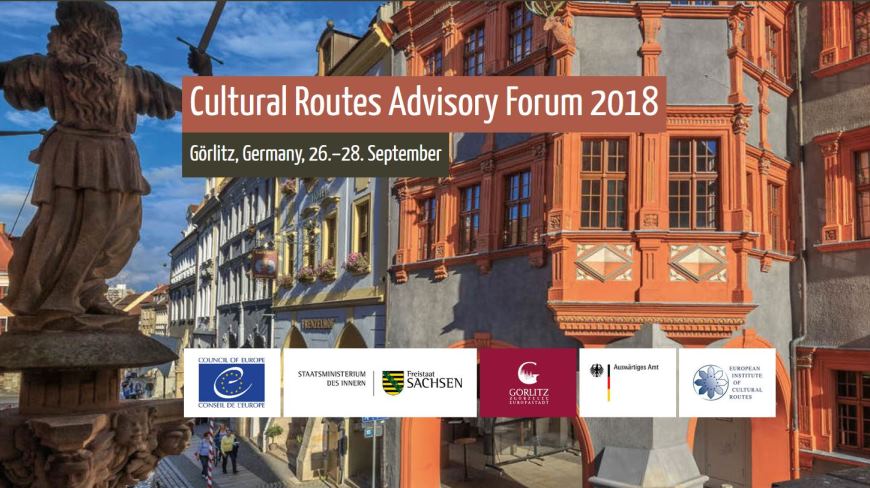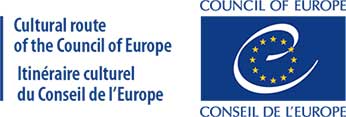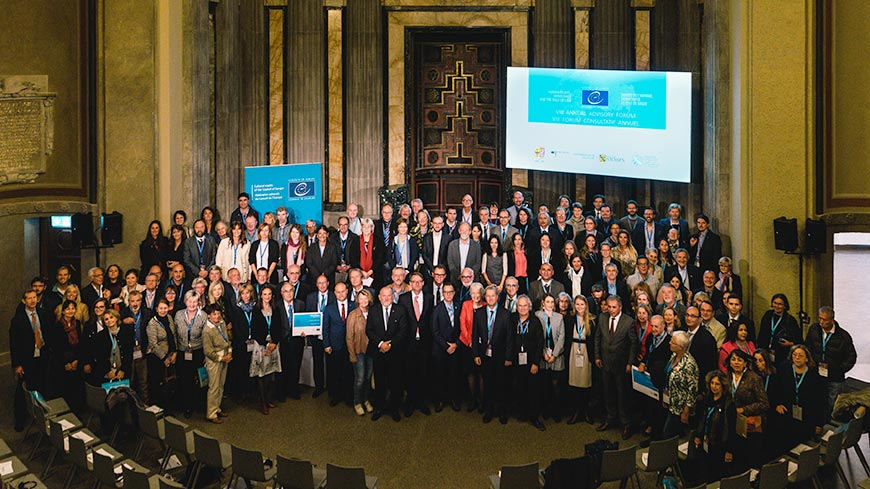
Roadmap
du 8ème Forum Annuel Consultatif sur les Itinéraires Culturels
Görlitz, Allemagne, 26-28 Septembre 2018
Cultural Routes of the Council of Europe connecting cultural values, heritage sites and citizens: strategies and synergies in a global perspective
Background
The Enlarged Partial Agreement on Cultural Routes of the Council of Europe (EPA) was established in December2010 and enables closer co-operation between member states interested in the development of Cultural Routes.
The Annual Advisory Forum is the most important and significant annual event of the Cultural Routes of the Council of Europe programme and it is the occasion to debate priorities, review progress of the implementation of the Cultural Routes and share experiences. Each Forum provides an occasion to discuss and provide guidelines on how to implement the EPA strategies, focusing each year on different topics.
The Görlitz Forum 2018 "Cultural Routes of the Council of Europe connecting cultural values, heritage sites and citizens: strategies and synergies in a global perspective", given particular attention to strategies and synergies between European Cultural Routes programme and International Organisations (UNESCO, European Union, UNWTO...) concerned with the protection and the promotion of cultural heritage.
Four main themes were explored:
- Cultural Routes of the Council of Europe and European Union programmes: existing and potential initiatives for future synergies;
- Cultural Routes of the Council of Europe and UNESCO World Heritage Sites: existing and potential future synergies;
- Strategies and synergies between EPA and International organisations;
- Strategies and synergies between EPA and National and regional organisations.
Görlitz Roadmap takes into account the Görlitz Forum Background Document, reflections and suggestions expressed during the Forum on those themes and list actions to be undertaken.
The participants of Görlitz Forum 2018 " Cultural Routes of the Council of Europe connecting cultural values, heritage sites and citizens: strategies and synergies in a global perspective", taking into account the declarations and documents elaborated at international level reiterate the considerations expressed in the Lucca Roadmap 2018:
The Committee of Ministers reaffirms Cultural Routes of the Council of Europe as a tool to:
The participants of Görlitz Forum 2018 " Cultural Routes of the Council of Europe connecting cultural values, heritage sites and citizens: strategies and synergies in a global perspective", taking into account the declarations and documents elaborated at international level reiterate the considerations expressed in the Lucca Roadmap 2018:
1.Promote a closer unity based on the values of the Council of Europe through better knowledge of European cultural heritage and the management of Cultural Routes by civil society.
Cultural Routes, as elements of cultural heritage, can thrive at its best through activities shared among partners within civil society and on the basis of the Council of Europe standards.
a) Organise in major cities scheduled, coordinated "presentations" of the Routes and their core principles, missions and examples, possibly connecting some of them thematically or geographically;
b) Continue raising awareness of the positive role of the cultural routes amongst wider civil society by developing outreach programmes using the widest range of media;
c) Organise activities dedicated to young people coming from different European Countries;
d) Integrating the message of the Cultural Routes programme into the ordinary curricula across the education system;
e) Promote the Cultural Routes as examples of good practice in the framework of the European strategy as indicated in the Recommendation of the Committee of Ministers of the Council of Europe to the Member States on the “European Cultural Heritage Strategy for the 21st Century” (adopted by the Committee of Ministers on 22 February 2017);
f) Inform the members of the "European Heritage Forum" group of experts (Member States and civil society) envisaged by the European Commission in the framework of the follow-up of the European Year of Cultural Heritage 2018.
2.Development of innovative approaches and international cooperation in the field of cultural heritage, sustainable tourism and local development.
Cultural Routes are “shared public spaces” and represent platforms to implement the conventions and recommendations of the Council of Europe on cultural heritage, landscape and spatial planning. Cultural Routes work actively to create connections between diverse regions of Europe, paying special attention to the inclusion of those less known.
a) Develop more cooperation amongst Cultural Routes and connect them to major arts exhibitions, cultural initiatives,and theatre / music festivals, according to their themes;
b) Develop tool-kits for routes to implement practices that will result in local and regional economic development based up the sensitive and sustainable valorisation of cultural heritage;
c) Develop digital application dedicated to Cultural Routes to be easily used by the Routes and the public to co-create contents;
d) Integrate Cultural Routes in EU territorial cooperation programmes and macro-regional strategies.
3.Encourage intercultural dialogue among member states of the Council of Europe and beyond.
Cultural Routes have increasingly become an instrument of cultural diplomacy. One of the aims of the Cultural Routes is to "promote dialogue between urban and rural cultures, between regions in the south, north, east and west of Europe, and between developed and disadvantaged regions" and "promote dialogue and understanding between majority and minority, native and immigrant cultures" (CM/Res(2013)67).
As stated in the White Paper on Intercultural Dialogue, “Cultural Routes [...] naturally cross borders and connect cultures. Art and culture create a space of expression beyond institutions, at the level of the person, and can act as mediators”.
a) Mobilise Cultural Routes as a mechanism for increasing social inclusion;
b) Encourage cultural routes to translate and communicate the values embodied in the cultural routes and to build mutual understanding of pan-European cultures;
c) Increase awareness about the charters, conventions, recommendations and work of the Council of Europe relating to culture and intercultural dialogue;
d) Enlarge the geographical coverage of certified Cultural Routes;
e) Supporttwinning agreements among regions and EPA member States;
f) Support students’ exchanges and experiences along Cultural Routes as a means for civic education.
4.Strengthen multilevel governance, cooperation and relationships at the international, European, national and local levels
The development of Cultural Routes relies greatly on policies and practices at national and regional level. Local communities are also fundamental to plan, implement, and manage Cultural Routes, guaranteeing their success and impacting cultural tourism.
a) Strengthen the role of the Cultural Routes as a voice for local communities so that they can input into national and international policies regarding sustainable tourism and regional and local cultural development;
b) Support and spread sustainable and responsible tourism enterprises and social entrepreneurship through specific training;
c) Introduce participatory processes in tourism planning.
5.Develop innovative approaches in the fields of research and development.
Cultural Routes offer the opportunity to develop multidisciplinary researches and stimulate cross-border cooperation. Research reinforces the work and the narrative of the Cultural Routes.
a) Foster the collaboration between scholars of humanities, arts and social sciences in order to define the needs / methods of "measurable" and "evidence-based" implications;
b) Explore new possibilities in research and development in order to effect creative approaches to cultural routes and to maximise their impact upon local communities and wider civil society;
c) Reinforcing the work of the university network and increasing the links with the Cultural Routes;
d) Widen the competences and disciplines of Universities involved in the NCRS;
e) Develop funding opportunities together with DG research for future calls on H2020.
1.STRATEGIES AND SYNERGIES BETWEEN EPA AND INTERNATIONAL ORGANISATIONS
1.1–STRATEGIES AND SYNERGIES BETWEEN EPA AND OTHER COUNCIL OF EUROPE INITIATIVES
ACTION 1 –COOPERATION WITH THE EUROPEAN HERITAGE DAYS INITIATIVE
In 1985, four years before the launch of the Cultural Routes programme, Council of Europe launched the European Heritage Days initiative.
The European Heritage Days are the most widely celebrated participatory cultural event shared by the citizens of Europe.
In 1999 was joined by the European Union to create the joint action, which has continued up to the present day.
EPA secretariat
1-Facilitate contacts and reinforce cooperation between EHD Programme and certified Cultural Routes
EPA Member states
1-Encourage the organisation of events along the Cultural Routes of the Council of Europe during the European Heritage Days at the national level, according to the theme selected by each country.
Cultural Routes of the Council of Europe
1-Stimulate the organisation of special events during the European Heritage Days in agreement with the National Authorities in charge of the EHD programme.
1.2–STRATEGIES AND SYNERGIES BETWEEN EPA AND EU PROGRAMMES
ACTION 1 –STRENGHTENING AND EXTENDING CULTURAL ROUTES OF THE COUNCIL OF EUROPE IN THE EU’S EASTERN AND SOUTHERN NEIGHBOURHOOD AS WELL AS THROUGH EU’S CANDIDATE COUNTRIES
In the Report on Towards an EU strategy for international cultural relations (2016/2240(INI)) European Parliament calls on the Commission and the EEAS to strengthen cooperation with the Enlarged Partial Agreement on Cultural Routes of the Council of Europe, an institutional tool for strengthening grassroots cultural relations also with third countries, with a view to promoting the fundamental values of cultural diversity, intercultural dialogue and sustainable territorial development of less well-known cultural destinations, while preserving their shared cultural heritage.
Cultural Routes of the Council of Europe can be reinforced at the National level encouraging a common work between EPA secretariat/ EICR, EPA Member states, and European Commission and European External Action Service.
EPA secretariat
1-Facilitate contacts between Member States to support the certified Cultural Routes in expanding their networks and to further develop the Cultural Routes Programme in the EU's Eastern and Southern Neighbourhood as well as through EU’s candidate countries;
2-Stimulate common strategies and policies to support geographical extension and partnership building;
3-Support the involvement of Countries located in the EU's Eastern and Southern Neighbourhood as well as through EU’s candidate countries involved in the Routes but not yet members of the EPA so they may join the Cultural Routes programme;
4-Preparation of a toolkit for the EPA’s Member States containing coherent information to be published on the official websites of the specialised Ministries and National Tourism Offices in the EU's Eastern and Southern Neighbourhood as well as through EU’s candidate countries;
5-Involvement of certified Cultural Routes crossing the targeted Countries during events and meetings.
EPA Member states, in particular those in the EU's Eastern and Southern Neighbourhood as well as through EU’s candidate countries
1-Disseminate the information material presenting the programme and listing the certified Cultural Routes;
2-Create events at the national level giving visibility to Cultural Routes of the Council of Europe, already and not yet involving the country, in particular in the EU's Eastern and Southern Neighbourhood, and EU’s candidate countries;
3-Continue supporting the preparation of language versions of statutory texts and key basic information (i.e. CM/Res on EPA and Cultural Routes’ programme, leaflets, text for websites, ...);
4-Facilitate contacts between certified Cultural Routes interested in expanding their networks and local stakeholders as potential members of the Routes;
5-Develop and support common strategies and policies at the national level to support geographical extension and partnership building;
6-Inform regional authorities about the Cultural Routes of the Council of Europe that potentially involve their territories.
ACTION 2 –STRENGHTENING SYNERGIE BETWEEN CULTURAL ROUTES OF THE COUNCIL OF EUROPE AND EU PROGRAMMES AND INITIATIVES (EUROPEAN HERITAGE DAYS/EUROPEAN CAPITALS OF CULTURE)
EPA secretariat
1-Facilitate contacts and reinforce cooperation with DGEAC on the EHL and European Capitals of Culture initiatives;
2-Support to Cultural Routes already cooperating on the ground with European Heritage Label/European Capitals of Culture.
3-Support expert discussions and thematic workshops;
4-Reinforce synergies focusing in activities connecting children and youth along the Cultural Routes in outreach initiatives;
5-Encourage the creation of common funding programmes focusing on Cultural Routes(Creative Europe,...);
6-Further involve the Cultural Routes in the preparation of project proposals answering the calls launched by the European Union in the field of culture and heritage.
EPA Member states
1-Reinforce synergies with national and local teams working on European Heritage Label and European Capitals of Culture applications and management.
Cultural Routes of the Council of Europe
1-Inform the Secretariat about existing practices at the crossroads between Cultural Routes and the European Heritage Label/European Capitals of Culture.
1.3–STRATEGIES AND SYNERGIES BETWEEN EPA AND UNESCO
EPA secretariat
1-Develop common strategies and reinforce communication at European and national level to support a common work in the WHL sites along the Cultural Routes;
2-Support expert discussions;
3-Organise thematic workshops involving Cultural Routes and sites inscribed on the WHL.
EPA Member states
1-Create cooperation with the UNESCO National Commissions.
Cultural Routes of the Council of Europe
1-Inform the Secretariat about existing practices at the crossroads between Cultural Routes and the WHL sites.
2-Take into account Recommendations and Charters of UNESCO, as stated in Resolution CM/Res(2013)67.
1.4–STRATEGIES AND SYNERGIES BETWEEN EPA AND ICOMOS
EPA secretariat
1-Develop common strategies and reinforce communication at the European level and in the Countries beyond Europe crossed by certified Cultural Routes.
EPA Member states
1-Create cooperation with the ICOMOS National Committees
Cultural Routes of the Council of Europe
1-Take into account Recommendations and Chartersof ICOMOS, as stated in Resolution CM/Res(2013)67.
1.5–STRATEGIES AND SYNERGIES BETWEEN EPA AND OEI (Organisation of Ibero-American States)
European Institute of Cultural Routes
1-Facilitate contacts between certified Cultural Routes interested in expanding their networks and the OEI;
2-Develop and support common strategies to promote the geographical extension of certified Cultural Routes of the Council of Europe and partnership building in the Ibero-American States.
3-Encourage the participation in cultural routes events, such as the Annual Cultural Routes Advisory Forum, the Annual Training Academy, and the extension of the University Network of Cultural Routes Research to Ibero-American Universities and other possible collaborations of mutual interest in the field of cultural cooperation linked to cultural routes and related projects and activities carried out by the EICR and the OEI.
4-Jointly apply for international funding with a view to implementing targeted cooperation programmes in Ibero-American States
EPA Member states
1-When applicable, introduce Cultural Routes of the Council of Europe as a vector to reinforce cooperation with the Ibero-American States.
Cultural Routes of the Council of Europe
1-Informing the EPA secretariat/EICR of the Countries potentially involved in the networks.
2.STRATEGIES AND SYNERGIES BETWEEN EPA AND NATIONAL, REGIONAL AND MACROCREGIONAL ORGANISATIONS
2.1–STRATEGIES AND SYNERGIES BETWEEN EPA AND MEMBER STATES
EPA secretariat
1-Encourage Member States and Cultural Routes of the Council of Europe to take into account the Recommendation of the Committee of Ministers of the Council of Europeto Member States on the European cultural heritage strategy for the 21st century.
2-Facilitate contacts between Member States supporting Cultural Routes and certified Cultural Routes interested in consolidating or expanding their networks;
3-Stimulate common strategies and policies strengthening Cultural Routes of the Council of Europe;
4-Implementation of an online Geodatabase containing the Cultural Route networksdata(Routes4U Macro-regions and EPA Member States).
EPA Member states
1-Develop and supporting common strategies and policies at the national level, in particular implement the Recommendation of the Committee of Ministers of the Council of Europe to Member States on the European cultural heritage strategy for the 21st century.
In the Recommendation of the Committee of Ministers of the Council of Europe to member States on the European Cultural Heritage Strategy for the 21st century (Adopted by the Committee of Ministers on 22 February 2017 at the 1278th meeting of the Ministers' Deputies),the Committee of Ministers of the Council of Europe, under the terms of Article 15.b of the Statute of the Council of Europe refers to the Cultural Routes of the Council of Europe as example of action for implementing recommendation D7, namely to “give consideration to heritage in sustainable tourism development policies”.
2-Facilitate contacts between certified Cultural Routes interested in expanding their networks and local stakeholders potentially members of the Cultural Routes networks;
3-Establish a National coordination for certified Cultural Routes;
4-Organise an informal meeting of the Ministries responsible for Tourism of the EPA Member states open to the other Council of Europe Member states and Cultural Convention signatory countries;
5-Encourage other Countries to join the EPA.
Cultural Routes of the Council of Europe
1-Cooperate with National authorities in the implementation of the Recommendation of the Committee of Ministers of the Council of Europe to Member States on the European cultural heritage strategy for the21st century.
2.2–STRATEGIES AND SYNERGIES BETWEEN EPA AND REGIONAL AND MACRO-REGIONAL AUTHORITIES AND ORGANISATIONS
EPA secretariat
1-Reinforce a dialogue and cooperation with Regional and Macro-regional organisationsand networks of Regions working on cultural heritage, cultural tourism, sustainable tourism,...
2-Continue informing macro-regional authorities on the Cultural Routes of the Council of Europe programme.
3-Implementation of an online geodatabase containing the Cultural Route network datain close cooperation with the European Union.
EPA Member states
1-Inform regional authorities on the Cultural Routes of the Council of Europe programme;
2-Stimulate common strategies and integrated policies at the Regional level strengthening the Cultural Routes of the Council of Europe.
Cultural Routes of the Council of Europe
1-Inform the EPA secretariat on the Countries potentially involved in the networks;
2-Work with National Representatives and National Authorities.
3.REINFORCEMENT OF THE FINANCIAL RESOURCES OF THE ENLARGED PARTIAL AGREEMENT
The Enlarged Partial Agreement on Cultural Routes resources may be reinforced, in order to strengthen its action and to develop activities dedicated to certified Cultural Routes.
Kulturforum Görlitzer Synagoge
Otto-Müller-Straße
02826 Görlitz (GERMANY)
Dom Kultury
Parkowa 1
59-900 Zgorzelec (POLAND)





